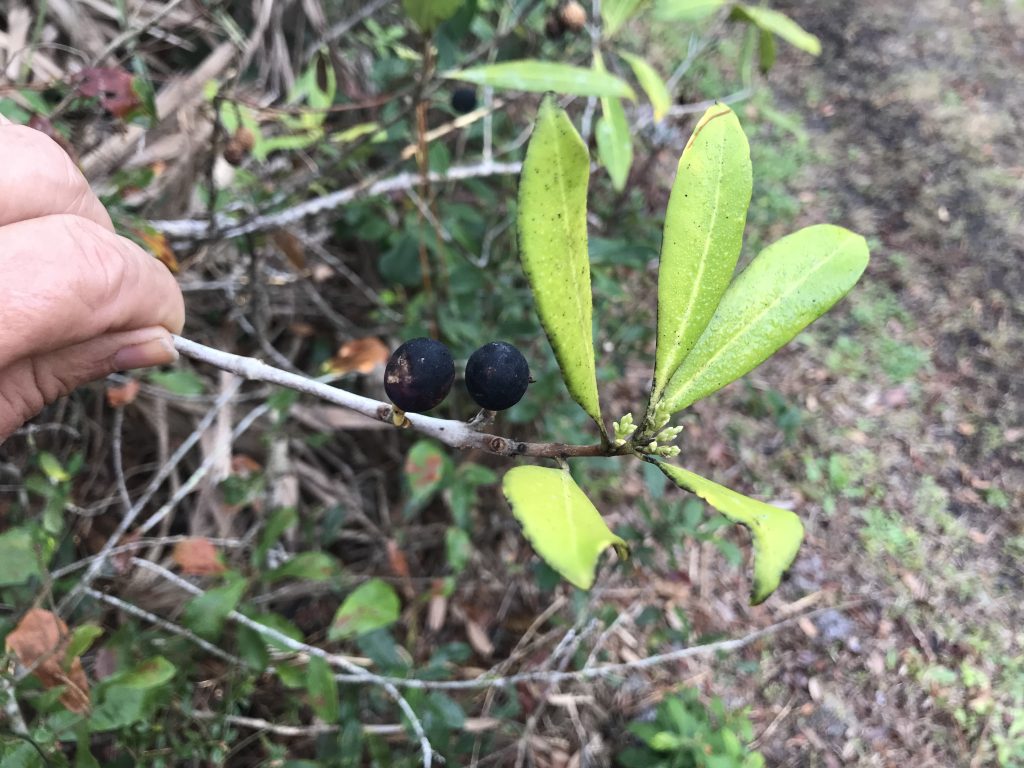
Osmanthus americanus and fruit, also called Devilwood. Photo by Green Deane
Mistakes can be fruitful. Several years ago I notice what appeared to be some kind of wild olive — Forestiera ligustrina, with round fruit — at Spruce Creek south of Port Orange. In fact there were several of them in one area. I didn’t study them, I just noticed they were there. (My personality is to not rush into new plants or mushrooms.) Then a few years later at Eagle Lake in Largo there was a planted “Florida Privet” — Forestiera segregata — heavy with fruit. It looked similar to the first though everything overall was smaller. However “Forestiera” and wild olive was linked in my mind.
The Forestiera in Eagle Lake had small, pointed oval fruit. I could not find any references on edibility. It has a relative, however, F. neomexicana, the Desert Olive, whose fruit were “used like olives.” This made me take a second closer look at the trees in Spruce Creek as the fruit were larger. My blindere was being stuck to the Forestiera genus and I didn’t look at other genera in the wild olive family. After studying the leaves and their arrangement the trees in Spruce Creek they were actually Osmanthus americanus, a different and edible wild olive called Devilwood.
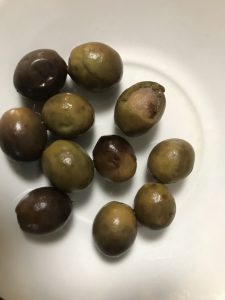
Osmanthus americanus fruit after brining. Photo by Green Deane
The main problem with these wild olives is they are bitter (so much so they were used only for making ink or a mixed with clay for body paint. As I also had seen someone eat them I brined a few hoping to remove their bitterness. It worked. They do taste like olives but the layer of pulp is paper thin. I brined them in a 10% solution that I changed once a week for a month. I also kept them submerged in the brine as one does when one lacto-ferments. Even though the pay off is small, adding another edible to the list is good. And as there is plenty of salt I don’t think making them edible is a difficult chore. Besides edible fruit the blossoms can be used to flavor or scent tea. I think they are too skimpy to collect any oil from plus that might concentrate some unwanted lipid compounds. The other headache is while I have published sources that say the wild olives are edible the internet says no. Some natives reportedly used F. segretata berries as an emetic ( I doubt they brined them.)
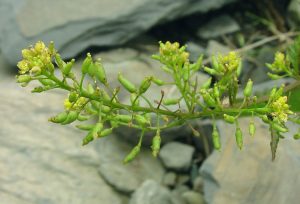
Rorippa palustris, Bog Yellow Cress
All mustards are edible, no matter where you are on earth, no matter what the species. And for several years I’ve seen a mustard that was like many others, not too distinguished but definitely in the mustard family. Several times I have wondered if it was a Sibara, a Erucastrum, or one of many the cresses that show up in our winter. This week a possible answer was provided while at Eagle Lake: A Cress, genus Rorippa, R. palustris, the Bog Yellow Cress and closely related to Sibara. There are ten Rorippa in Florida and four versions of the palustris (good luck sorting them out.) I haver found them near fresh water, not in it, but in places where rainwater can stand.
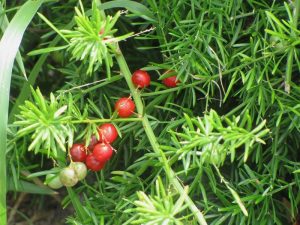
Aspargus densiflorus, are the fruit edible?
Perhaps it was a week for discovery. I have seen someone eat the red fruit of the ornamental Asparagus Fern prompting me to hit the library (I don’t hit the internet because most sites cut and paste copy each other. You can read the exact same entry on multiple sites. Books in the library tend to not copy each other.) There are, officially, six Asparagus in Florida: A. aethiopicus, A. densiflorus, A. officianlis, A. plumosus, A. setaceus, and A. sprengeri. A. officinalis is the garden Asparagus so we know that is edible and has escaped from cultivation here and there. Other known edible species include A. aphyllus (cooked bitter shoots) and A. cochinchinensis (fruits and roots after the roots are preserved in sugar… bitter I suppose.) All of the species are in the lily family which makes them deadly to cats and perhaps toxic to dogs and horses, too. Several sources agree the red Asparagus fruit is not too toxic and the sap can irritate the skin some. Several of the species are thorny and can cause dermatitis. There are many Asparagus mentioned in the Journal of Economic Botany but none of ours are covered. Francois Couplan, author of The Encyclopedia of Edible Plants of North America, says while the seeds in the red fruit can be used as a coffee substitute the red fruit” are rich in saponins and can cause digestive trouble and hemolysis.” (Hemolysis is rupturing red blood cells, a common problem with many wild peas and why they are either not edible or only used as a famine food, that is, for a short duration.) He writes the roots of several European species of asparagus are eaten raw or cooked. Australia does not consider A. densiflorus toxic. I would not have explored the plant except I know someone who ate some fruit and did not appear to experience any acute issues. Maybe they are a trailside nibble.
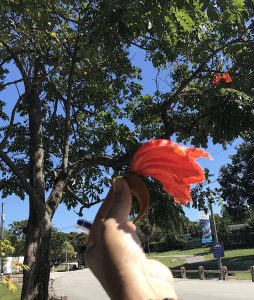
The large blossoms of the African Tulip Tree, a monotypic genus. Photo by Green Deane
Fourth on the discovery list this week was the African Tulip Tree, which was right next to the Coralwood Tree in Dreher Park, west Palm Beach. It was blossoming heavily thus drew notice. Like several species perhaps the edibility is slight but it is inside that realm. Cornucopia II says on page 49: “The flower buds contain a sweet, water liquid that is considered tonic. Winged seeds are said to be edible.* Pharmaceutical research on the species reports that “Spathodea campanulata is traditionally used in the treatment of various disorders. The bark pulp is used in oedemas, skin diseases like herpes and sores. In Gabon, the crushed bark and flowers have been applied to ulcers. The cold leaf infusion is used to treat urethral inflammation and bark decoction has been reported to be used to treat kidney disorders. In Senegal, the bruised leaves and flowers are used in wound treatment and ulcers. The flowers are employed as diuretic and anti-inflammatory, while the leaves are used against kidney disease, urethra inflammation and as an antidote against animal poisons. Also, the leaf decoction has been used for the treatment of gonorrhoea and women‘s pelvic disorders. In Ghana, the bark infusion is used for the treatment of dysentery and stomach ache.” And the flower buds can be used by kids like a water pistol: Just squeeze them.
Incidentally, the next entry in Cornucopia II after the African tulip Tree is the Pink Trumpet Tree, Tabebuia impetigonosa of which there are many locally. The inner bark is brewed into a tonic tea that was favored by Ghandi and Czar Nicholas II of Russia. *Curiously most of the plants I am interested in are in the first 170 pages of Cornucopia II. I rarely ever have a reason to look at anything in the next 705 pages. Thus my copy is falling apart at page 170.

Classes are held rain or shine or cold. (Hurricanes are an exception.) Photo by Kelly Fagan.
Foraging Classes: Braving the cold weather of Jacksonville this weekend with a class on the northeast side of the city in Atlantic Beach. Then Sunday then back to a favorite location, Mead Garden in Winter Park.
Saturday February 26th, Tide Views Preserve, 1 Begonia Street, Atlantic Beach Fl 32233 (near Jacksonville Fl.) 9 a.m. to noon. Meet at the parking lot.
Sunday February 27th, Mead Garden: 1500 S. Denning Dr., Winter Park, FL 32789. Meet at the bathrooms. 9 a.m. to noon.
Saturday March 5th, John Chestnut County Park: 2200 East Lake Road, Palm Harbor, FL 34685. Meet at the trail head of the Peggy Park Nature Walk, pavilion 1 parking lot. 9 a.m. to noon.
Sunday March 6th, Mead Garden: 1500 S. Denning Dr., Winter Park, FL 32789. Meet at the bathrooms. 9 a.m. to noon.
Saturday/Sunday May 7th & 8th, Honea Path, South Carolina, classes at 9 a.m. and 1 p.m. each day.
For more information, to pre-pay or sign up go here
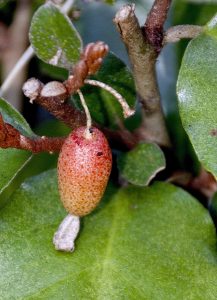
Silverthorn berries ripen in about Valentine’s Day. Photo by Green Deane
Silverthorn is definitely in fruit. We’ve been seeing ripening berries for several weeks and found a lot of sweet ones this past weekend. Locally it is a very common hedge plant that is rather easy to identify. It has green waxy leaves that are silver on the back with rusty freckles. The fruit is about the size of a jelly bean and light red with silver and gold sprinkling. You can read about it here, and a video here. Also flowering this week and will be fruiting soon is Eastern Gamagrass. A clumping ornamental (and native) it has a frilly flower spike that turns into grains that can be used like wheat if you can get them out of their husk. You can read about it here.

Green Deane videos are now available on a USB.
My nine-DVD set of 135 videos has been phased out and replaced by 171-videos on a 128-GB USB. The USB videos are the same videos I have on You Tube. Some people like to have their own copy. The USB videos have to be copied to your computer to play. If you want to order the USB go to the DVD/USB order button on the top right of this page or click here. That will take you to an order form. Or you can make a $99 donation, which tells me it is for the USB (include a snail-mail address.) I’d like to thank all of you who ordered the DVD set over the years which required me to burn over 5,000 DVDs individually. I had to stop making them as few programs now will read the ISO files to copy them.

Green Deane Forum
Want to identify a plant? Perhaps you’re looking for a foraging reference? You might have a UFO, an Unidentified Flowering Object, you want identified. On the Green Deane Forum we — including Green Deane and others from around the world — chat about foraging all year. And it’s not just about warm-weather plants or just North American flora. Many nations share common weeds so there’s a lot to talk about, such as the one to the left. There’s also more than weeds. The reference section has information for foraging around the world. There are also articles on food preservation, and forgotten skills from making bows to fermenting food. Recent topics include: California Wild Mushroom Parties, A Good Reason To Eat Wild Garlic, Black Walnuts and Amaranth, Sea Salt and Plastic, Wild Mustard? Heavy Metals. Oriental Persimmons. What is it? Pine Cough Drops and Needles, Skullcap, Malodorous Plant? Another NJ Tree, Maypop? Roadside Plant, Unknown in Sudan, Please Help Identify, and Preserving Prickly Pear Bounty. You can join the forum by clicking on the button on the upper right hand side of this page.
This is my weekly newsletter #496. If you want to subscribe to this free newsletter you can find the sign-up form in the menu at the top of the page. My website, EatTheWeeds.com, which is data secure, has over 1500 plants on it in some 428 articles. I wrote every one myself, no cut and paste.
To donate to the Green Deane Newsletter click here.

